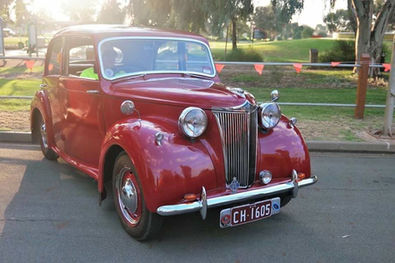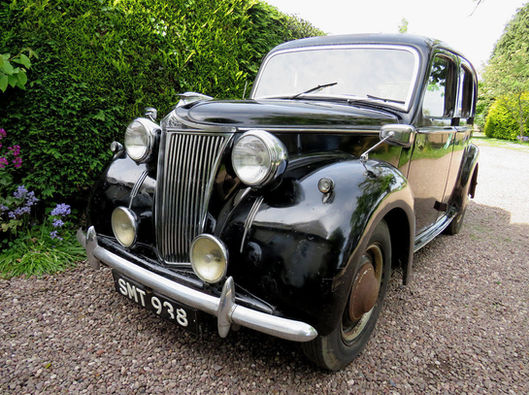Lanchester LD10 1946- 1951
The LD10 was one of the smallest vehicles to be built by the Lanchester Motor Company (under Daimler ownership). It was first conceived before the war and production would have gone ahead if the restrictions on steel had not prevented the chassis manufacturers (Briggs Motor Bodies) from supplying the chassis that were needed for vehicle build. The car was designed with a "modern" vee-shaped grille and would have been well ahead of its time if the war had not halted its production.
Chassis allocation:
Prototypes:
L60000 to L60024 total 25
Briggs - 1st series
(April 1946 to June 1947)
L60025 to L61024 total 1000
Briggs - 2nd series
(June 1947 to April 1948)
L61800 to L62799 total 1000
Briggs - 3rd series
(April 1948 to November 1949)
L62800 to L63225 total 426
Barker
(June 1950 to June 1951)
L63226 to L63804 total 579
Total 3,030
USEFUL DATA
Number of cylinders 4-in-line, overhead valves,
capacity 1287 c.c.
63.5 Bore X 101.6 mm stroke,
BHP: 40 at 4,200 r.p.m.
R.A.C. RATING: 10 h.p.,
COMPRESSION RATIO: 7.1 to 1
Firing order: 1,3,4,2.
Sparking Plugs: NGK BP6E (modern equivalent)
Cooling system capacity:
2 Gallons
Engine oil capacity: 8 pints
Transmission
Pre-selective Wilson gearbox mated to Daimler fluid flywheel
Gear ratios:
1st ....... 21.40 to 1
2nd ....... 11.65 to 1
3rd ....... 7.55 to 1
Top ....... 5.0 to 1
Reverse ... 31.15 to 1
Rear axle ratio 5.1
CHASSIS DESIGNATION
LD10
35' turning circle
8'3" wheelbase
4' track (front and rear)
overall length 13' 2 1/4"
Ground clearance is 6",
weight of chassis is 22 cwt
Capacities
Fluid Flywheel:
5 1/2 pints of SAE 30 oil.
Four-speed gearbox:
4 pints of SAE 30 oil.
Rear axle:
capacity 3 pints (recommend Extreme Pressure EP140 grade)
Petrol tank:
8 gallons
(Inc. 1 1/4 gallons reserve)
Tyres:
5.1/4" x 16" tyres.
Tyre pressures:
26 psi (front) and 28 psi (rear)
Road Test dates
11th September 1946
The Motor
"The Lanchester Ten"
27th September 1946
The Autocar
"Lanchester Ten Saloon"
July 1947
The Motor Sport
"The Lanchester Ten"
14th September 1949
The Motor
"A Coach built Lanchester Ten"
Dimensions

History. Darren Watkinson
The 1939 prototype car still exists and is very interesting, because all the wing pressings are shaped to take the vee-shaped grille but have been disguised and adapted to carry the traditional flat, pre-war grille, presumably to prevent competition from seeing the new design. 95% of the first 2,426 chassis (1946 to 1949) were fitted with saloon bodies built by Briggs Motor Bodies Ltd. of Dagenham and 95% of the last 579 chassis (1950 and 1951) were fitted with coach-built bodies built by Barker and Co, at the Radford Works, Coventry. The remaining 5% (or so) were fitted with a range of interesting bodies, including several vans, several two-door drophead tourers and several saloon car bodies built by other coachbuilders. Other known coachbuilders include Avon, Hooper and Wentworth.

The well-mannered small car of high quality, the Lanchester Ten, appeared for 1950 with a new four-door four-light coach-built saloon by Barker. The mechanical design of the chassis has not been altered; however, the appearance is both modern and attractive. Beneath the prepossessing exterior there is an interesting construction, for the body is a strong composite structure of steel, timber framework, light alloy centre pillars, and aluminium alloy panelling for roof, doors, boot, and lid. This construction should also save weight. At the back is a capacious luggage locker, the lid of which opens upwards to give access to the compartment and to the spare wheel locker beneath it.
The interior accommodation of the new saloon provides two bucket front seats, both independently adjustable for leg reach, whilst the driving seat has a vertical adjustment as well. The wide rear seat has a folding centre armrest and elbow-rests at the side.


The drop windows of the four doors, which are hinged to the centre pillars, are of curved Triplex glass to reduce the thickness of the doors and so allow extra width in the body at waist-line height. To economize weight and increase rigidity the windscreen is fixed, and a sliding roof is not incorporated. The equipment is thorough and includes such items as pockets in all doors, a large glove box with a private lock. The instrument panel and the cappings are carried out in polished walnut instead of painted metal as in the Briggs. To conform with overseas regulations the number plate is not inbuilt but bolted on and provided with separate illumination. There are oblong rear lights in the tails of the wings. One small change was made to the compression ratio being reduced from 7.6 to 7 to 1 for low-octane fuel.
Known Coachbuilders
Briggs of Dagenham
Barker & Co London
E. D. Abbott of Farnham
Hooper & Co of London
Mumford’s, Abbey Garage, Plymouth
Avon Coachworks of Warwick
B.S.A.,
H. J. Mulliner & Co.Bedford Park, Chiswick, West London.

'Specials'
Three factory cars fitted with Barker Body and one Abbott-bodied Drophead Coupe from 1st series chassis range
One Utility bodied by Mumford’s, Abbey Garage, Plymouth from 2nd series chassis range
One Abbott-bodied Drophead Coupe from 3rd series chassis range
One Hooper-bodied LD10 Van from the Barker chassis range

Maintenance Manual/Handbook
The accompanying cover scans illustrate the following:
Lanchester LD10 Handbook 1st Chassis 60025 to 61024
Lanchester LD10 Handbook 2nd Chassis 61800 to 63799
Lanchester LD10 Handbook 2nd Abridged Version Chassis 60025 to 61024, 61800 to 62799, 62800 to 63225 Briggs and 63226 to 63804 Barker
Lanchester LD10 Handbook 1950-51 Model with Coach built Body Chassis 62800 to 63799

Spare Parts Catalogues
The accompanying cover scans illustrate the following:
Lanchester LD10 604-4 L60025 - L61024
Lanchester LD10 604-7 L61800 - L63228
Lanchester LD10 Supplement to Above 604-8 L63139, L63228, L63232 Onwards

Wiring Diagram





























